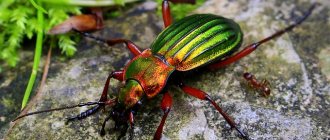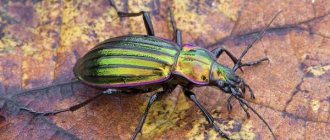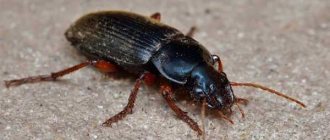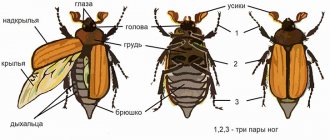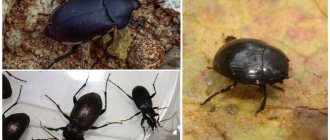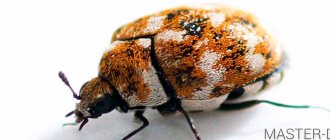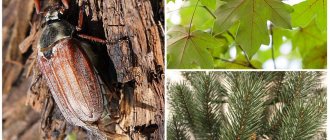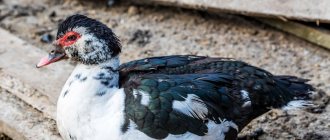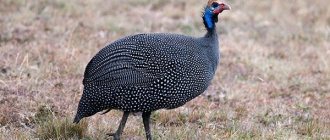The float beetle or spinning beetle is a unique creation of nature; its abilities can sometimes amaze lovers of flora and fauna.
Today, there are more than 800 species of these wonderful animals, which mostly live in the tropics, just like the weevil.
It seems incredible, but, nevertheless, it is a fact that this type of beetle is capable of not only flying, but also diving under water and sliding along its surface.
It constantly moves in the water without rest and hunts for small insects.
Appearance
— Imago
The size of the beetle reaches from 4-8 to 4-5 mm. The head of an adult has two pairs of eyes, the eyes located on the top of the head are intended for viewing the territory during flight, and the other pair located on the sides closer to the neck is used for the underwater environment.
The body of the beetle has an oval shape and a fairly hard frame; the color of the upper side of the body is shiny or blue-black. It has a pair of well-developed membranous wings, which are located under strong elytra.
Also, our wonderful character is endowed with three pairs of limbs; the first pair is long and thin, it is used for catching prey. It has very sharp lower jaws, which, if caught, the prey will have no chance of escape.
The middle and rear pair of legs serve the beetle for comfortable movement in the water column and on its surface; the limbs resemble the shape of oars no more than 2-3 mm long.
— Larva
The body of the larva is quite thin and long, more than 15 mm, almost two or three times longer than the adult beetle, consisting of thirteen segments.
Limbs for movement appear only on the first three segments of the body. For more convenient movement, they are equipped with small teeth in the form of hooks. Gill appendages; They help the larvae breathe under water; they are located on the last ten segments of the body.
Swimming beetle description
This large insect belongs to the order Coleoptera. Since its main habitat is water bodies, the diving beetle species ideally contributes to this way of life: the most streamlined and smooth upper cover; a head attached to the body without a neck; flat hind legs in the form of oars, front legs with sharp hooks for clinging to seaweed. The structure of the swimming beetle is aimed at facilitating the movement of individuals of this species in the water column: its low weight facilitates easy ascent to the surface, but the diving beetle requires significant effort to dive. When the reservoir dries out, the beetles are forced to fly to a new habitat.
Insects go through a full development cycle from eggs to beetles, and adult diving beetles reach 4 cm in length. They prefer standing bodies of water such as a pond, a large puddle, or a lake, where they mainly hunt tadpoles, newts, small fish, and worms. In extreme cases, algae can be used as food. Swimming beetles are ruthless predators. Unlike other beetles, which kill their prey before eating, they devour the prey alive, tearing off pieces from it.
Males differ from females by the presence of special “plates” on their front legs: they help keep the females in place during mating.
Lifestyle
These are very energetic inhabitants of the water surface of almost any body of water. On warm, hot summer days, they gather in small groups and quickly circle on the surface of the water.
The larvae spend their entire lives under water, they are fierce predators, catch small insects and, with the help of their mouthparts, in which the suction mechanism (channel) is located, are able to suck out the entrails from their prey in the shortest possible time.
We also note that the spinning beetle is the fastest swimmer of all animals of its species living in the aquatic environment; it is capable of developing incredibly high speed and covering a distance of one meter in one second. To develop such speed, he is helped by the middle and paddle-shaped limbs, which carry out 60 strokes (stroke) in 1 second .
In cloudy or cloudy weather, they hide under water, under dense coastal vegetation or on the shore. Imago is able to survive winter
, and in the spring they begin to mate.
In the period from August to September they can be observed in large numbers in reservoirs, this is due to the fact that at this time the season of transformation from pupae into adult floater beetles begins.
What do cockchafers eat?
In April-May, the female diving beetle lays 2.25 mm eggs on the stems or leaves of plants, from which larvae emerge after 2-3 weeks. They reproduce in large numbers in ponds, causing great harm, destroying fish larvae and fry.
Bedbugs destroy significant quantities of small aquatic animals and their larvae, which are food for fish. In addition, they cause great harm: they are carried in spawning ponds, destroying; larvae and fry of fish. Bedbugs reproduce in large numbers in bodies of water.
Enemies of fish larvae and fry:
1-2 - big water lover; 3 - its larva; 4-5 small water lover; 6 - its larva; 7-8 - swimmers; 9 - their larva; 10 - ilnik; 11 - its larva; 12 - gargle; 13 - its larva; 14 - tinkle; 15 - its larva; 16 - rower; 17 - its larva; 18 - motley rower; 19 - its larva; 20 - pond snail
Aquatic bugs include the water strider, water strider, water scorpion, ranatra, gladipp, and corixa.
Water scorpion (Nepa cinerea). Its bites are very painful for humans. Eggs are laid as pendants on aquatic plants.
Plautus (Neucoris cimicoides). The bug-like creature is 1.5 cm long and has oar-shaped legs, with which it swims quickly.
Cylindrical eggs are laid in ponds.
Gladysh (Notonecta glauca). It differs from its relatives in that it floats on its back. The female lays eggs on plants. After hatching from the egg, the offspring are similar to the adults, emerging in May.
It should be noted that water bugs catch larvae and fry, but do not eat them, but absorb them. They are combated by draining and liming ponds.
Dragonfly larvae (Aeshana spec, and Libellula spec.) are dangerous predators for young fish.
Dragonfly larvae have a mask. The lower jaw suddenly extends and grabs the larva or fry, after which the dragonfly crushes the victim with its mouthparts and swallows it. All dragonfly larvae are bottom settlers, which makes them difficult to destroy.
Here it is necessary to liming and draining reservoirs, removing from them plants on which dragonfly eggs are laid.
Plankton. Of all the planktonic invertebrates in ponds, Cyclops is the most dangerous for the larvae of carp, white and bighead carp, grass carp and other fish species that still feed on the yolk sac.
Cyclops
Getting into the incubation apparatus with water, it causes significant harm, attacking sedentary and helpless larvae. The cyclops causes damage both in trays for raising larvae and in spawning ponds. In this regard, water from reservoirs must be passed through mill gas filters.
Large numbers of fish are destroyed by rats, ferrets, cats and many other animals.
Predatory fish such as perch, pike, rotan, American catfish, etc. also cause a lot of harm.
Water bugs and dragonfly larvae:
1 - smooth bug; 2 - water scorpion; 3 - floating; 4 sodium; 5 - dragonfly larva: a, c - mask pressed; b,d the mask is thrown away
Nutrition
Basically, its diet is not very varied; the daily menu may include mosquito larvae, and sometimes it can eat carrion: dead cockchafers that have fallen into the water, hornets, paper wasps and other insects.
If you are interested in good quality mosquito photos , you can view and download them by following this link.
How does a ground beetle enter a human home?
This pest is found not only in the garden or vegetable garden, but also in apartments, country houses, and also in private houses. They penetrate into a person’s home as follows:
- Beetles and larvae can appear in the house along with wood, as well as with street garbage.
- These insects are attracted to the smell of pet food if they are not taken care of and food remains are left behind.
- Ground beetles easily enter the house through open windows and doors. Therefore, it is advisable to install mosquito nets on the windows and cover the doorways with transparent fabric.
- These beetles can live in old furniture, under window sills, in crevices of window frames, etc.
- In addition, housewives often find them among bulk food products.
Reproduction and development cycle
After hibernation from March to April, they begin the breeding season. After a while, the female lays eggs on aquatic plants. After a few weeks, the hatched larvae do not look at all like their parents; the appearance of the larvae is described above.
When the time comes, she will walk along the plant to the shore and begin building a cell of mud. This is not an easy task, so she spends a lot of energy and effort, since the larva is unadapted for life on the surface of the earth.
After all the procedures, the larva spins a cocoon; it will remain in the pupated state until mid-August.
Twirly
The whirligig (Gyrinus) belongs to the order of beetles and belongs to the family of whirligigs (Gyrinidae).
These small shiny bugs scuttle amazingly quickly on the calm surface of the waters, describing circles and spirals. They are usually found in whole flocks; Sparkling in the sun, the whirligigs animatedly plow the water. Scared by the approach of an observer, they quickly move away from the shore or dive. It takes some dexterity to catch them with a net.
The movements of the whirligigs are observed on excursions by placing the animals in a flat plate of water. Water should be poured no more than 0.5 cm, otherwise the beetles dive and it is not possible to see their movements on the surface of the water. The spinner is the best swimmer among aquatic beetles. The dexterity and speed of her circular movements are inimitable. When swimming, the bug exposes its convex dorsal side to the surface - black, blue-black or greenish, with a bright metallic sheen, smooth like a mirror. Feet remain under water. To examine their structure, let a bug crawl along the palm of your hand. It is easy to see that both rear pairs of legs are greatly shortened and expanded, like fins or flippers. By hitting the water with them, the bug develops a speed that surprises us while swimming. The fatty lubricant covering the body reduces friction with water and promotes speed of movement.
Twister (Gyrinus). Increased On the left is an adult beetle; on the right is the larva.
The breathing of a whirligig is easy to observe if you let it swim not in a plate, but in a deeper vessel, for example, in a glass of water. The bug immediately dives, taking with it a spherical air bubble at the rear end of its abdomen. Consequently, the whirligig has not an aquatic, but an air type of respiration, like terrestrial beetles.
Nutrition. The whirligig is a predator and feeds on small aquatic animals. Despite the fact that the bug spins on the surface of the water, the structure of its eyes allows it to simultaneously navigate what is happening in the water element and look out for prey. Looking at the eyes of the spinner, you will notice that each eye is divided into two parts, lower and upper. The lower part of the eye is adapted for underwater vision, the upper part is adapted for aerial vision. The animal's double life - on the border between the water and the air - left its mark on its senses.
The protective devices of the spiny bug can be well demonstrated on an excursion by inviting one of the excursionists to catch the bug with their fingers from a plate of water. The bug successfully dodges the pursuing fingers, and it is extremely difficult to grab it in this way. It is recommended to smell the caught bug, lightly squeezing it between your fingers. A pungent odor is felt, reminiscent of the smell of valerian drops, which depends on the caustic volatile substance secreted by the whirligig from special anal glands lying in the back of the abdomen. It can be assumed that this smell scares away animals, which sometimes attack the wigglers.
Reproduction. Sometimes an excursionist’s net catches the larvae of whirligigs, which, like the larvae of other aquatic beetles, lead a predatory lifestyle under water. They differ from most other beetle larvae in that they bear paired tracheal gills on body segments. Thanks to water respiration, these larvae never rise to the surface of the water and are relatively rarely encountered on excursions.
Red Book
Based on the total number of individuals living on Earth, one conclusion can be drawn that this type of insect is not in danger.
However, one must take into account the fact that every year humanity clogs thousands of freshwater bodies of water, which can negatively affect their population as a whole.
The main culprits are newly opened production zones that release chemicals (waste) into nearby rivers and lakes, which has a detrimental effect not only on the population of these beetles, but also on all living organisms living in these bodies of water.
Unique insect abilities
May beetles fly at a speed of three meters per second - quite good for a small creature. In good weather conditions, they cover up to twenty kilometers per day. The flight altitude of the insect ranges from six to one hundred meters. The flight goal of all varieties of the cockchafer is always green spaces. The eastern insect prefers the nearest forest or tall trees. And western cockchafers orient themselves during flight to the highest objects in the distance, as a rule, these are forests.
A feature of these unique insects is their ability to find the right path. Studying the habits of the beetle, biologists caught them and moved them to a completely different place, releasing them after a couple of days. No matter how incredible it may seem, the insects took the same course, as if they were programmed to fly in a certain direction.
It is still unknown how beetles navigate. On the one hand, they determine the direction by the sun, but on the other hand, they fly perfectly even in the evening, when there is no sun. Apparently, polarized light is enough for them to understand where to move. Biologists even suggest that cockchafers are able to remember their surroundings, focusing on the most noticeable objects.
Vitamin B1 deficiency
Hypovitaminosis B1 occurs in young and adult pigeons, but more often it is detected during periods of intense metabolism (during growth, egg laying, mating). This vitamin is not synthesized in the body. It is detected in the intestinal flora - when supplied with food, B1 is absorbed in the small intestine. Insufficient supply of thiamine causes damage to the peripheral motor nerves and leads to symptoms of spinal cord. The vitamin is present in:
- shell and germs of grains, seeds;
- yeast;
- herbal flour;
- sprouts.
The norm of these products in case of hypovitaminosis is increased. In severe cases, injections and the introduction of thiamine chloride into the food are indicated. The norm is 2 mg/1 kg of feed mixture.
Precautions on how to properly keep a sick pigeon
An important condition for preventing infection with the whirligig is keeping the pigeons clean and observing all sanitary and hygienic standards. Pigeons need to be inspected regularly. If signs of an infectious disease are detected, the bird is immediately isolated from the rest.
The litter must be submitted to a veterinary clinic for analysis. In this way, it is possible to determine what disease has affected the pigeon. This will help to prescribe treatment in a timely manner and save the bird.
Important! Cells must be disinfected regularly using the drug Deitran. It effectively removes the virus that causes whirlwind. The product is not dangerous for pigeons, so the treatment can be carried out overnight without removing them from the premises.
Since the virus dies at high temperatures, you can use heat treatment of the dovecote using hot air.
The risk of infection can be reduced by observing sanitary standards.
Processing and disinfection
As soon as a sick bird is discovered, it must be housed separately to avoid contact with healthy birds. It is necessary to disinfect the pigeon room. Thoroughly treat all surfaces and equipment used for cleaning. These activities are carried out for 5 days from the moment a sick pigeon is discovered, and then another 14 days after the last individual recovers.
Another preventive measure is mandatory disinfection every 30 days, even if there are no manifestations of any diseases.
It is important to remember that not only sick birds can spread the virus. It is carried on eggshells and inventory items. It also affects things in the immediate vicinity of the dovecote. A person can also become a source of infection, as well as protective clothing that has not undergone timely disinfection. No less dangerous spreaders of pseudoplague are feather mites that parasitize pigeons.
It is important to remember that each strain requires its own disinfectant to neutralize.
The survivability of viruses has already been discussed in the article. Ethers, heat and disinfection solutions pose a particular danger to it. When carrying out the relevant work, you need to remember:
- bleach 3-4% - death of the virus within 3 minutes;
- formalin solution – 1% – death after 30 minutes;
- heating to 55 degrees - death after 30 minutes.
How to carry out complex disinfection:
- Low-value equipment used in poultry care must be destroyed.
- The livestock is transferred to another room while the main dovecote is being treated with toxins.
- Cleaning perches and walls using scrapers.
- Wash the above-described parts using a solution of laundry soap at the rate of 0.5 kg per 10 liters of water.
- Carrying out disinfection.
- Ventilation of premises.
- Washing food and water containers.
- As an additional means, blowtorches are used, whose flame destroys viruses and parasitic insects that may remain in cracks, crevices or other places with difficult access.
- At the last stage, you can add new food and fresh water, and then transplant the birds.
There are several modern, but expensive disinfection enterprises that are carried out without stocking. This includes a number of gaseous agents that treat not only the room, but also the feed, as well as the feather cover of the bird. There is one caveat here: complete disinfection will be successful only if the dovecote is completely sealed and the temperature is not lower than 15 degrees.
Newcastle disease (whirling disease) in birds. Review
Newcastle disease (lat. Pseudopestis avium), fowl pseudoplague, whirling plague or Asian fowl plague is an acute infectious (viral) disease of birds (primarily the chicken family), manifested by pneumonia, damage to the nervous system, and multiple pinpoint hemorrhages in the internal organs.
Historical reference. Newcastle disease was first described in Indonesia on the island. Java in 1926. After 1 year, the disease caused mass deaths of chickens in the area of Newcastle (England), for which it received its name. Further, the infection manifested itself many times in the United States, and also caused the death of poultry in Europe and Russia. The causative agent of the disease is an RNA-containing virus of the Paramyxoviridae family, found in four strains (species), different in the nature and severity of the disease. The virus is resistant to environmental factors and, as a result, can be transmitted over long distances, causing new outbreaks. The source of infection in birds is a sick bird. The pathogen is transmitted by airborne droplets, as well as through food and water (puddles of rainwater). A sick bird 1 day before the appearance of external clinical signs begins to release the virus into the external environment. Most often, this infection affects chickens, turkeys, guinea fowl, parrots and some granivores. Cases of the disease have been described in parrots (Greys, Amazons), quails, pheasants, sparrows, jackdaws, thrushes, goldfinches, starlings, crossbills, bullfinches, owls, sparrow owls, Moscow tits, greenfinches, chaffinches, sparrowhawks, and kestrels. People can also become infected with Newcastle disease by inhaling dust contaminated with the virus or introducing the virus to the conjunctiva of the eyes with contaminated hands. However, people's susceptibility is low. The disease mainly affects people who have constant contact with large numbers of poultry. The incubation period of the disease in humans lasts 3–7 days. Infection manifests itself as conjunctivitis and influenza-like syndrome (with a low temperature similar to acute catarrh of the respiratory tract). Does not pose a danger to life. However, in children there have been cases of the disease with signs of damage to the nervous system.
Clinical signs in birds are varied. In the classic course, there is a slight increase in temperature, decreased appetite, and lethargy. In the future, symptoms of respiratory damage may appear in the form of suffocation, digestive disorders (diarrhea, colored green). Mucus begins to ooze from the beak and nostrils, the bird often makes swallowing movements, and conjunctivitis is pronounced. Acute cases of the disease are accompanied by the death of the bird. Cases of mild and asymptomatic infection have also been reported. Clinical symptoms are less typical: loss of appetite, diarrhea, rhinitis, conjunctivitis, shortness of breath. Only a small number of birds experience severe disorders of the central nervous system: neck twisting, loss of coordination, paresis and paralysis.
In pigeons, the disease occurs in several stages. At the beginning, an unsteady gait appears, the head tilts to one side, and appetite is reduced or retained in full. Next, neurological symptoms suddenly arise and intensify. The pigeon begins to rotate its head (hence the name “twirling”). Often the bird loses coordination and takes an unnatural pose (falls over on its back or side, moves its legs, trying to get up). At the same time, food and water intake is disrupted. Paralytic signs intensify when the bird is frightened by something. Against the background of the disease, general exhaustion develops (due to the inability to eat normally). The disease takes a long time (chronically), and death occurs mainly from exhaustion. In some individuals, the disease enters a protracted stage with periodic apparent recovery. Sparrows infected with B. Newcastle exhibit ataxia, swaying of the body, loss of balance, leaning on the wings, and convulsions with stretching of the neck. Then a coma develops and the bird dies. Parrots show symptoms of neck twisting, paralysis of legs and wings, and seizures. In some birds, the disease passes in a latent form without clinical signs, but such birds pose a great danger as a source of infection. The diagnosis of Newcastle disease in veterinary medicine (in poultry farms or during mass outbreaks in wild or urban birds) is made comprehensively, taking into account epidemiological, clinical and pathological data. An accurate diagnosis can only be obtained after laboratory testing to isolate and typify the virus. Among similar diseases, it is necessary to exclude poisoning, pasteurellosis, infectious laryngotracheitis, fowl typhus, spirochetosis, and classical fowl plague.
Effective prevention has not yet been developed. One of the prevention methods is the use of a vaccine for poultry. Vaccines for chickens are used (La Sota, Gam 61, Nobilis). Adult healthy birds tolerate the administration of the drug without any external changes. The vaccine should not be used on birds that are already sick. The vaccine does not have any medicinal properties.
When comparing the results of immunization in different species of parrots, it was noted that intense immunity is formed in cockatoos and Amazons, while the results are worse for budgerigars. Immunity appears 8 days after the vaccine is administered. Its activity lasts up to 2 months, after which a new vaccination is required. To achieve longer-lasting immunity, vaccination of parrots is carried out twice at an interval of 3-4 weeks. It is recommended to vaccinate pigeons against Newcastle disease twice a year. Another method of prevention is regular disinfection of premises where birds are kept. An extremely important point in the prevention of viral diseases in birds is a nutritious and varied diet. Birds that live outdoors or have regular access to the outdoors, as well as free-flying birds (that have regular exercise), tolerate treatment more easily and are less likely to get sick than those confined indoors or in a small enclosure without access to direct sunlight.
Treatment. As such, there is no official treatment regimen for Newcastle disease (according to veterinary legislation, sick birds must be destroyed, since they are dangerous for people and other birds, being a source of infection). However, against the backdrop of the inaccessibility of reliable diagnosis of the disease, a new form has been formed on the Internet. The following is a treatment regimen for birds with Newcastle disease. This scheme showed itself best in the treatment of pigeons: 1. Fosprenil (vet) or immunofan (vet/med). 2. Piracetam or nootropil (honey). 3. Vitamin complexes: catozal, vitasol, milgamma, kombilepen 6. Antibiotics (to suppress secondary bacterial infections): ampicillin, augmentin, amoxiclav, baytril, tylosin, ciprofoxacin. 6. Antifungal drugs: pimafucin or nystatin. 5. Symptomatic and supportive therapy: brewer's yeast, Vetom 1.1, carsil, methionine, “glycine water” (1 glycine tablet per 25 ml of water).
When intensive treatment of the bird begins at the stage of the first signs of the disease disappearing and the bird maintains interest in food, cases of clinical recovery of birds (primarily pigeons) are regularly observed.
Veterinarian Artem Arkadevich Kazakov.
